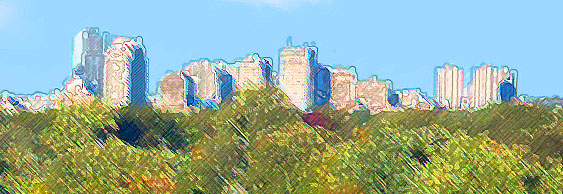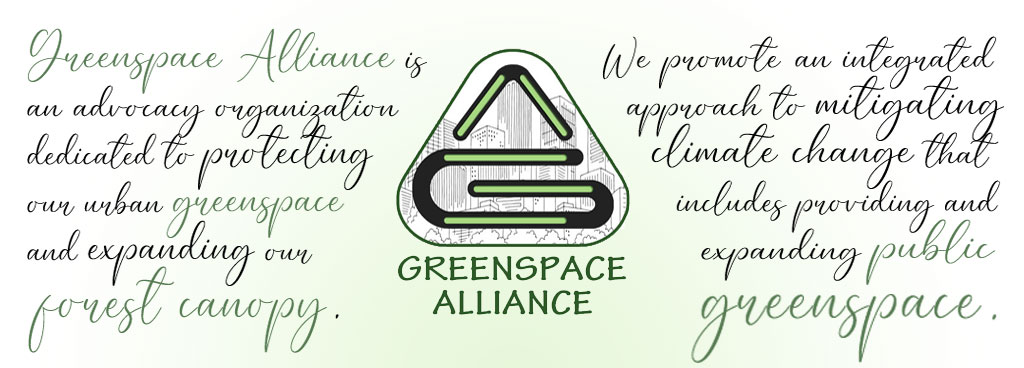
Welcome to Greenspace Alliance. We are an environmental advocacy group focused upon electing city governments committed to protecting and expanding urban greenspace in Canadian cities. We see this as an existential and urgent need because cities need more greenspace and some - including London, Ontario - have no plans to increase their greenspaces and their tree canopy goals are inadequate.

Global warming is causing catastrophic fires, floods, droughts and upending lives across the globe. Polar warming is taking place at an unprecedented rate. The melting of glaciers is predicted to raise the level of our oceans. We are facing an existential crisis.
The cause of this crisis is the heat and carbon dioxide being emitted by our cities, factories, industries, and vehicles powered by internal combustion engines. Greenspace Alliance has chosen to focus on making Canadian cities active agencies of change in the fight against global warming.
Since all growing plants absorb carbon dioxide and emit oxygen, any greenspace where plants are growing is a small force combating the overheating of our planet. Therefore, it only makes sense to not only protect the greenspaces we have in our urban areas, but to increase the amount of greenspace in our cities and expand our urban canopies.

The pandemic of 2020/2021 has shown us that human beings need access to greenspace for mental and physical health. All municipalities must recognize their obligation to provide and protect greenspace for all citizens, as part of a blueprint for public health and proactive preparation for future pandemics. 1 2

As important as grass and smaller plants are, it is impossible to overstate how vital trees are in cooling cities and mitigating the effects of climate change. Trees shade cities, sequester and store carbon, remove chemical pollutants from the air, and tree root systems prevent flooding.3 4 5 6
Trees also help save on energy costs. When homes are shaded by trees, property owners benefit from lower air conditioning costs during summer. This savings also benefits the climate because they are using less energy. Yet, this benefit pales in comparison to the lifesaving results of reducing the heat that our cities radiate. A cooling urban canopy can save lives, as was established in Canada following a devastating heat event, in Montreal, in 2018. Sity-six deaths were attributed to this heat event and the lack of tree cover in the areas of Montreal where the deaths occurred. 7 8 9
In Montreal, tree cover is greater in historically wealthier areas. The south-west and eastern parts of the city have much less canopy. 10 11 12

An experiment which studied the cooling effect of the urban canopy was completed in Madison, Wisconsin in 2019. The results proved that a city's tree canopy needs to approach forty percent in order to achieve significant cooling benefits.13
The cooling effect studied is, essentially, caused by evapotranspiration which turns our urban forests into immense air conditioners. 14 Therefore, the forty percent canopy has become a benchmark used by many cities in their urban canopy strategic plans. Here are current forest canopy goals for cities in sourthwestern Ontario:15 16 17 18
- Guelph (2017 population 135,474) 40% by 2031 (23% in 2021)
- Hamilton (2017 population 579,200) 30% by 2041 (21% in 2021)
- London (2017 population 404,699) 34% by 2065 (est. max. 26% in 2021)
- Oakville (2017 population 211,382) 40% by 2057 (27.8% in 2021)
- Toronto (2017 population 2.9 million) 40% by 2050 (31% in 2021)
It's important to note that it takes a minimum of ten to fifteen years for a tree planted today to start "putting on canopy," so that it can take 25 to 30 years to see a significant increase. As London, Ontario is the fastest growing city in Ontario - and the 4th fastest growing city in Canada - we believe the current canopy goal is too low, too slow, too late, too weak and will be ineffective in providing protection from heat events in the face of accelerating global warming. Therefore, we are focusing on strategies to turn London, Ontario into a city that - instead of lagging behind - leads the way in the protection and acquisition of greenspace and the expansion of tree canopy. Please review our proposed strategy for London.

We must protect and expand our urban greenspaces and tree canopies. There are many ideas about how to increase tree canopies and overall greenspace in our cities. Walk down any city street and you will see strips and pockets of land that are barren, paved over or otherwise under utilized. Encouraging roof gardens, planting mini-forests in strips of unused land, and planting food forests or dense flowerbeds between sidewalks and curbs are just a few ways to increase the number of plants that can remove carbon and heat from our urban landscape.
Yet, without forward thinking individuals in our city governments who are willing to work proactively to help us come together and create more greenspaces, nothing will happen. Therefore, it is imperative for us to elect representatives who recognize our collective need for urgent action to protect and expand our urban greenspaces.
Please join us and let us work together for the benefit of the earth, our children, their children, and children yet to come.
References
1Kardan, Omid, and Peter Gozdyra, Bratislav Misic, Faisal Moola, Lyle J. Palmer, Tomáš Paus, Marc G. Berman. 2015. “Neighborhood greenspace and health in a large urban center.” Nature 5 (July)
2Bratman N., Gregory, and J. Paul Hamilton, Kevin S. Hahn, Gretchen C. Daily, and James J. Gross. 2015. “Nature experience reduces rumination and subgenual prefrontal cortex activation.” Proceedings of the National Academy of Sciences of the United States of America 112 (July)
3ECCC (Environment and Climate Change Canada). 2020a. National Inventory Report 1990–2018: Greenhouse Gas Sources and Sinks in Canada. Government of Canada. Retrieved from https://unfccc.int/documents/224829
4EPA. 2019. “Using Trees and Vegetation to Reduce Heat Islands.” https://www.epa.gov/heatislands/using-trees-and-vegetation-reduce-heat-islands
5GreenBlue Urban. 2017. “How Trees Increase Property Values.” https://greenblue.com/na/how-trees-increase-property-values/
6McDonald, Rob. 2016. “Planting Healthy Air: Can Urban Trees Help Clean Up Pollution?” The Nature Conservancy, 31 October 2016. https://blog.nature.org/science/2016/10/31/planting-healthy-air-can-urban-trees-help-clean-up-pollution/
7Steenberg, James WN and Pamela J Robinson, Peter N Duinker. 2018. “A spatio-temporal analysis of the relationship between housing renovation, socioeconomic status, and urban forest ecosystems.” Urban Analytics and City Science 46 (6): 1115-1131
8Laaidi K, et al. (2012) The impact of heat islands on mortality in Paris during the August 2003 heat wave. Environ Health Perspect
9Anderson GB, Bell ML (2011) Heat waves in the United States: Mortality risk during heat waves and effect modification by heat wave characteristics in 43 U.S. communities. Environ Health Perspect 119:210–218.
10City of Montreal. 2012. “Plan d’Action Canopée 2012-2021.” Direction des grands parcs et du verdissement.
11City of Montreal. 2014. “Réponse du comité exécutif au rapport de la commission permanente sur l’eau, l’environnement, le développement durable et les grands parcs portant sur le plan d’action canopée 2012-2021 et sur l’infestation de l’agrile du frêne” Retrieved from Ville Montreal PDF document
12City of Montreal. 2016. “Annuaires Statistiques.” Ville Montreal Portal Page
13Ziter, Carly D. and Eric J Pedersen, Christopher J Kucharik, Monica G Turner. 2019. “Scale-dependent interactions between tree canopy cover and impervious surfaces reduce daytime urban heat during summer.” Proceedings of the National Academy of Sciences 116 (15): 7575-7580
14EPA. 2019. “Using Trees and Vegetation to Reduce Heat Islands.” https://www.epa.gov/heatislands/using-trees-and-vegetation-reduce-heat-islands
15Julien Bourque et al "Growing Forest in a City: A Case Study", Canadian Institute For Climate Choices, Smart Prosperity Institute 2021
16Urban Forest Strategy https://engage.hamilton.ca/urban-forest-strategy
17City of Toronto. 2020. “New tree canopy study shows increase in Toronto’s tree population.” Retrieved from https://wx.toronto.ca/inter/it/newsrel.nsf/
18Globe and Mail, How planting trees can cool Canada's cities in an era of climate heating, published July 3, 2021.

